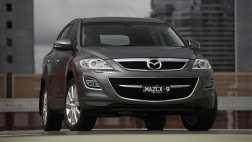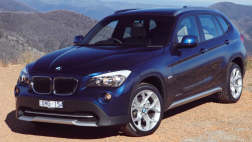Jaguar's new XKR has those traits in abundance, yet it can be as docile as a house tabby.
There are few more unforgiving environments than the luxury sports tourer market, inhabited by the likes of Porsche, BMW and Mercedes-Benz. It really is a jungle out there.
Jaguar was well aware if its newest top cat — recently launched world-wide in Spain — was going to survive, let alone thrive, it had to have the right stuff.
"When we started down this track there were some truths we knew we had to face," Jaguar senior body engineer Mark White explains.
"The goal was to create the ultimate sports GT and to do that we set the target of exceeding the XK by some 30 per cent in a whole range of performance criteria."
What the Jaguar engineers aimed for was a performance benchmark of five seconds for the 0-100km/h sprint — they achieved a 4.9 for the coupe and a five flat for the convertible. But more importantly, the performance had to be accessible in the crucial mid-range for overtaking and it had to be refined.
"Torque ... and how it was delivered ... was the key to meeting our performance goals," White says. "I have to say the result has exceeded initial expectations."
Australian owners will start taking delivery of their XKRs about April next year.
Jaguar Australia will not say how much the cars will be, other than to suggest a 30 per cent premium over the XK models. That would see the coupe about $245,000 and the convertible tipping over $270,000.
Based on the strong demand for the basic XK and with the XKR historically comprising about two-thirds of XK sales, Jaguar Australia is expecting sales of about 80 a year. A large part of the XKR's credentials come from the high standards set for the new XK; the "base" car.
"In the XK we had a starting platform that was simply outstanding," White says. "In a way, that posed some difficulties in that realising the 30 per cent improvement benchmark we set was always a challenge because of how high the bar was to start with."
While there was no need to further stiffen the already superbly rigid chassis and all-aluminium body of the XK, the XKR engineers concentrated on providing an engine with extra heart, suspension that delivers a stiffer ride without additional harshness, and brakes capable of reigning in a rampant XKR when required.
Strapping the supercharger to the 4.2-litre V8 was the obvious first step and with it came variable valve time on both inlet and outlet cams. The power boost was some 40 per cent over the XK, taking maximum power to 313kW at 6250rpm and a thumping 560Nm of torque from 4000rpm.
The whipcrack engine has been coupled to the latest of the ZF automatic gearboxes. Featuring shift changes as smart as 600 milliseconds and as smooth as custard, the box can be driven as a full automatic in cruise mode, a sports automatic with computer-generated blips on the downshifts or as a full-control manual utilising the wheel-mounted paddle shifts.
To keep the extra urge from its attempts to separate car and road, the spring rates were stiffened 38 per cent at the front and 28 per cent at the rear, rollbar thickness was increased by a millimetre and damper response improved by 25 per cent.
The CATS (computer active technology suspension) system — that switches the dampers between soft and firm — has a similar response time to the XK but has been tweaked to switch from soft to firm earlier.
The other critical area of improvement is in the braking. Compared with the XK, the R car has 26 per cent greater swept area on the discs and a huge 37 per cent improvement in cooling efficiency. The heftier brakes can haul the XKR down from 100km/h to zero in a most reassuring 2.5 seconds.
One of the joys of the XKR, particularly the convertible, is the oh-so angry exhaust howl at full throttle. If you happen to be in a tunnel through the Spanish hills, so much the better.
Unlike the Aston Martin with its clever engine-speed-activated butterfly valve or Maserati's push-button arrangement, the XKR's throaty exhaust note is a simple affair. The more you poke it, the louder it growls. The XKR does utilise active exhaust technology, which alters the flow through the primary silencer, depending on throttle position and revs. But it is progressive rather than arriving with a howl at about 4000rpm, as does the Aston.
However, poke it really hard and you risk scaring yourself. In any event, you will certainly draw the attention of anyone within a considerable radius. What is not immediately obvious is the expected induction whine of the supercharger. It is far more muted than the outgoing model — or than the same engine tuned for the S-Type R.
At full roar, it adds a menacing undernote to the exhaust but is surprisingly absent at anything from idle to comfortable cruise ... just the way the engineers planned it.
What is absolutely reassuring about the XKR at full charge is the rock-like stability through the most testing of mountain roads.
With the stability control in operation the intervention is gentle and unobtrusive.
Each time you think the limits of adhesion are approaching and push that little harder the chassis finds even more suction-like grip.
It was a test of nerve that the XKR eventually won. We simply couldn't push hard enough on public roads to reach the dynamic limits of the car.
The styling variations for the XKR are subtle. There's a chrome mesh grille and side airvents and a couple of discreet R badges.
The sports seats are firm, comfortable and sensibly bolstered. General trim is stylish, the standard navigation system simple to use and, in the convertible, the flip-up airblocker behind the seats proved effective in reducing cabin buffeting with the roof down at speed. As with many of the 2+2 GT cars, there's a pointlessness to the rear seats which are so cramped as to be almost useless.
FAST FACTS
Price: estimated $245,000 (coupe), $270,000 (convertible)
Engine: 4.2-litre DOHC 32-valve V8, supercharged, 313kW@6250rpm, 560Nm@4000rpm
Transmission: 6-speed automatic with sequential shift; steering wheel mounted paddle shifts
Performance: 0-100km/h 4.9sec (coupe), 5sec (convertible); top speed 250km/h (limited)
Fuel: 12.3L/100km combined cycle (supplied); 71-litre tank
Jaguar XKR 2006:
| Engine Type | Supercharged V8, 4.2L |
|---|---|
| Fuel Type | Premium Unleaded Petrol |
| Fuel Efficiency | 13.6L/100km (combined) |
| Seating | 4 |
| Price From | $30,470 - $36,740 |
Range and Specs
| Vehicle | Specs | Price* |
|---|---|---|
| Base | 4.2L, Premium Unleaded Petrol, 6 SPEED AUTOMATIC | $30,470 - $36,740 |

















.jpg)
.jpg)

Comments